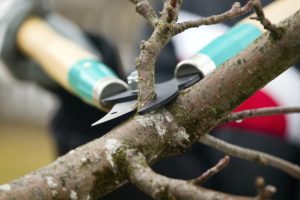
Pruning can promote healthy plant growth, but only when done correctly.
Plant pruning is the removal of undesirable portions of a plant. The dormant season is a great time to assess your plants and determine whether any pruning is required. Pruning is an excellent way to clear your plants of infected, loose, or overgrown branches and leaves that are impacting their health. If you are unfamiliar with the practice of plant pruning, read on to learn the basics of what makes this maintenance task so beneficial.*
Pruning Basics
Plan each pruning cut well because each has the potential to affect the growth of the plant. After pruning, the plant must heal every cut. The plant will seal over the wound by forming a callus or scar tissue. Small cuts require less energy for the plant to repair. Pruning cuts should leave smooth surfaces, without ragged edges or torn bark. If a small percentage of a young, growing branch is pruned, there will be regrowth up and down the remaining branch. When a large portion of a branch is pruned, the one or two buds closest to the cut will grow at a rapid rate. In general, removing just the growing tips will cause more branching than the removal of a large portion of the branch.
Why Should You Prune?
- To train newly planted trees and shrubs and promote better establishment.
- To maintain plant health.
- Remove dead, diseased, or damaged wood.
- Remove crossing and rubbing branches
- Rejuvenate declining shrubs or perennials by stimulating growth
- Prune overly-dense plants to allow for better air circulation
- To improve the quality of the plant’s flowers and fruit
- To promote the desired appearance
- To restrict growth
Pruning Techniques
Deadheading
Removal of spent flowers so that energy usually spent producing seed can be diverted to vegetative growth.
Twig Pruning
Control the shape of a plant by pruning back to a bud or branch pointing in the direction where future growth is desired.
Large Branch Pruning
Branches over 1 ½ inch diameter require a three cut process to avoid leaving a ragged wound and ripped bark. First, make an upward cut halfway through the branch about a foot beyond where the branch joins the truck. Second, make a downward cut through slightly farther out than the first cut. This will eliminate the excess weight of the branch. Now make the third and final cut just outside the collar, which is the thickened area at the branch’s intersection with the trunk. You should never cut the branch flush with the trunk, which will remove the collar. Contrary to what was once recommended, do not apply any paint or other coatings on the cut. Research has shown that dressings can shelter disease organisms and slow the healing process.
Renewal Pruning
Renewal pruning keeps shrubs such as Nandina, Lilac, and Forsythia compact and healthy. First, remove the weakest stems. Then, remove the oldest branches that sit just above ground level, leaving the younger more vigorous branches. Remove stems less than pencil thickness.
Thinning
Removal of a branch, sucker, or water sprout to its point of origin.
* Adapted from University of Maryland’s HG 84 Pruning Ornamental Plants
Scientific Plant Service Is Your Go-To Source In Landscape Healthcare
Scientific Plant Service, located in Baltimore, is a privately owned corporation, chartered in Maryland in 1957 by Frank J. Burke. We started as a full-service Arborists specializing in the care of shade trees and ornamental shrubs, but today we are a Lawn Care company that is a huge part of the community. From aquatic environments and snow management to deer and mole control, SPS has services tailored specifically for your lawn and landscape.
We offer services in Maryland, Washington, DC, and Virginia, including: Harford, Baltimore, Carroll, Frederick, Howard, Anne Arundel, Montgomery, Prince Georges, Talbot, Queen Anne’s, Calvert counties in MD, as well as Loudoun County, Fairfax County, Arlington, Alexandria, and Falls Church in VA. For more information, contact us online, or call us at 410-321-0970. Be sure to follow us on Facebook, Twitter, LinkedIn, and Pinterest!

